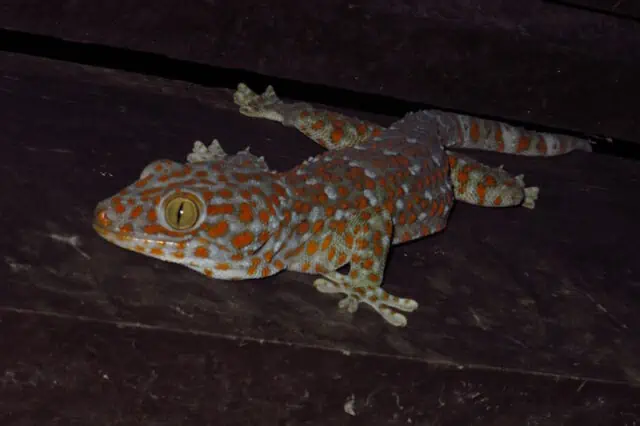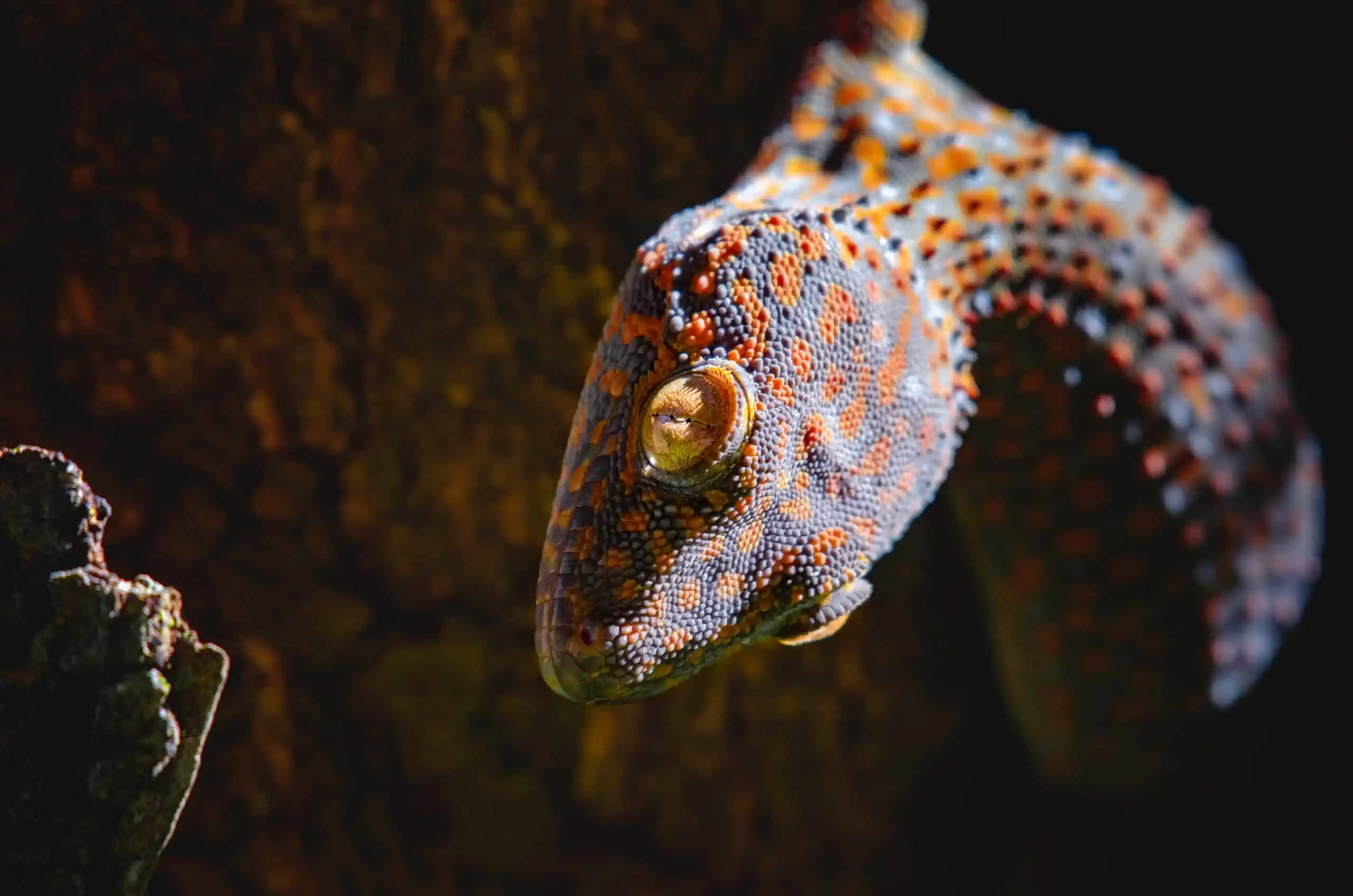Isn’t it captivating to watch your Tokay Gecko with its bright colors, moving gracefully inside its terrarium? These unique reptiles are a joy to own, but they also come with their own set of behaviors that can seem strange, if not outright perplexing, to those new to their care. Among these behaviors, one that often stumps owners is the act of the gecko licking its eyes. So, what does it mean when your Tokay Gecko licks its eyes? In this article, we’ll unravel this curious behavior, alongside some other common signs you may observe in your scaly friend. This understanding will help you to provide better care for your gecko, ensuring it leads a happy, healthy life.
Understanding Tokay Geckos: Basic Information and Habits
Tokay Geckos, scientifically known as Gekko gecko, are among the largest geckos in the world, with adults reaching lengths of up to 15 inches. Native to the rainforests of Southeast Asia, these nocturnal creatures have distinct, vibrant blue or grey bodies speckled with bright red or orange spots, earning them the moniker of “blue gecko”. Their vivid colors are not their only distinguishing feature; they’re also famed for their loud vocalizations, which are reminiscent of their name “To-kay!”
These geckos are arboreal, meaning they prefer to dwell in trees and are equipped with specialized toe pads that allow them to scale even smooth surfaces. In the wild, Tokay Geckos are insectivorous, primarily feeding on various insects and small invertebrates. In captivity, their diet can be supplemented with other foods, such as baby mice.
Tokay Geckos are solitary animals, and unlike some geckos, they don’t display sociable behaviors. They’re also known for their aggressive demeanor when threatened, and they can deliver a strong bite if they feel cornered. However, with regular handling and interaction, they can become more accustomed to human presence.
In terms of their natural behaviors, Tokay Geckos display a range of actions that, while commonplace in their world, may seem bizarre to us. One of the most curious behaviors is the act of licking their own eyes. To the uninitiated, this might appear worrisome or even harmful, but understanding the reasons behind this can help put your mind at ease.
Why Do Tokay Geckos Lick Their Eyes?
Tokay Geckos, like many other reptile species, exhibit several behaviors that are critical for their survival, both in the wild and in captivity. Eye-licking is one such behavior. The reasons for this behavior can be broadly categorized into three areas: moisture retention, a cleaning mechanism, and potentially a sign of stress or illness.
Moisture Retention
In their native habitat, Tokay Geckos are exposed to high humidity levels. This damp environment is essential for their well-being, playing a crucial role in hydration, shedding, and overall health. However, in a terrarium setting, maintaining this high humidity can be challenging. One way geckos adapt to these conditions is by licking their eyes.
Unlike humans, geckos don’t have eyelids to blink and moisten their eyes. Instead, they have a transparent scale, called a spectacle or brille, that covers and protects their eyes. To prevent this protective layer from drying out, they will lick their eyes to keep them moist.
Cleaning Mechanism
Eye-licking also serves as a grooming behavior for Tokay Geckos. Living in a terrarium or in the wild exposes them to dust, dirt, and small debris. When these particles land on their eyes, they use their long, agile tongues to remove them. This is crucial because their eyes are vital for hunting and avoiding predators, and any obstruction could significantly hinder these activities.
Sign of Stress or Illness
While eye-licking is typically a normal behavior, excessive licking could indicate a problem. It might be a sign that your gecko is uncomfortable or stressed. This could be due to an inadequate habitat, such as improper temperature or humidity levels, or it could be a symptom of an illness. Eye issues like infections or injuries could cause your gecko to lick its eyes more than usual. Hence, it’s essential to monitor your gecko and consult with a reptile vet if you notice anything unusual.
How to Read Your Tokay Gecko’s Behavior: Other Common Signs and What They Mean
Understanding your Tokay Gecko goes beyond deciphering their eye-licking behavior. Observing and interpreting other actions can provide valuable insights into their health, well-being, and overall mood. Here are some other common signs and what they might indicate:
Vocalizations: As mentioned earlier, Tokay Geckos are renowned for their distinctive vocalizations, which sound similar to their name, “To-kay!” These sounds are often used as a means of communication, especially during the breeding season. However, excessive or unusually loud vocalizations could be signs of stress or discomfort.
Tail Waving or Wagging: Tokay Geckos may wave or wag their tails when they feel threatened or agitated. It’s a defensive behavior that serves as a warning to potential predators or intruders to keep their distance.
Hiding: While Tokay Geckos are naturally nocturnal and prefer to hide during the day, excessive hiding, especially during their active night hours, could indicate stress, illness, or unsuitable habitat conditions.
Shedding: Like all reptiles, Tokay Geckos shed their skin regularly. This process, known as ecdysis, is a sign of healthy growth. However, if your gecko is having difficulty shedding, or if the skin doesn’t completely come off, it could indicate problems related to humidity levels or health issues.
Changes in Eating Habits: Monitoring your gecko’s appetite can provide important health clues. A sudden loss of appetite might be a sign of illness. Conversely, overeating can lead to obesity, which brings its own set of health problems.
Changes in Droppings: A sudden change in the consistency, color, or frequency of your gecko’s droppings can indicate various health issues, including parasites, digestive problems, or other illnesses.

Providing the Best Care for Your Tokay Gecko
As an owner, your primary responsibility is to create an environment for your Tokay Gecko that closely mirrors its natural habitat. Let’s go through some key elements you should consider:
Habitat Setup: A large, vertically oriented enclosure is preferred due to their arboreal nature. Equip the terrarium with branches, hiding spots, and plants to offer your gecko plenty of climbing and hiding options. Ensure the terrarium is escape-proof as these clever creatures can easily exploit any openings.
Temperature and Lighting: Tokay Geckos require a temperature gradient in their enclosure, with a basking spot of around 85-90°F (29-32°C) and a cooler end at about 75-80°F (24-27°C). Nighttime temperatures can drop slightly but should not fall below 70°F (21°C). UVB lighting should be provided for 12-14 hours daily to help them synthesize vitamin D3, which aids in calcium absorption.
Humidity: Maintain a humidity level of around 70-80%, as they are native to humid rainforests. Misting the enclosure once or twice a day can help achieve this. Ensure the enclosure also has good ventilation to prevent mold growth.
Diet: Provide a varied diet of live insects such as crickets, mealworms, and roaches. Dust the insects with calcium and vitamin D3 supplement to ensure your gecko’s nutritional needs are met. Feeding should take place in the evening when they are most active.
Handling: Tokay Geckos can be aggressive and are not typically a hands-on pet. However, with patience, regular interaction, and gentle handling, they can become more comfortable with their human caregivers.
Healthcare: Regular vet check-ups can help catch any potential health issues early. If you notice any unusual behavior, such as excessive eye-licking, reduced appetite, lethargy, or changes in droppings, consult a reptile vet immediately.
Proper care for your Tokay Gecko involves ongoing learning and patience. Paying attention to their needs and behaviors will not only ensure their health but also enhance the bond you share with your scaly friend.
Conclusion
Owning a Tokay Gecko can be an exciting and enriching experience. Their unique behaviors, like eye-licking, can initially seem bewildering, but they make more sense once understood in the context of their natural instincts and physiological needs. Learning to interpret these behaviors is an essential part of responsible ownership, enabling you to provide the best possible care for your gecko.
Remember, observing your gecko’s behavior is key to understanding its needs and detecting potential problems early. Regular check-ups with a reptile vet will also help ensure your gecko stays in the best of health. As you become more attuned to your gecko’s unique language, you’ll find yourself forming a closer bond with your colorful companion.
In the end, your Tokay Gecko’s health and happiness will largely be a reflection of the care and attention you provide. With time and dedication, you’ll become fluent in the language of your gecko, forging a rewarding relationship that lasts for many years.
FAQs
Are Tokay Geckos good pets?
Tokay Geckos can be great pets for those who appreciate their unique behaviors and are ready to meet their specific care requirements. They are beautiful, fascinating creatures but are also known for their aggressive demeanor. With regular, gentle handling, they can become more accustomed to their human caregivers.
How long do Tokay Geckos live?
In captivity, with proper care, Tokay Geckos can live between 10 to 20 years. This long lifespan makes them a considerable commitment, so it’s essential to be prepared for this before adopting one.
What should I do if my Tokay Gecko is not eating?
A loss of appetite in your Tokay Gecko can be due to several reasons, including stress, illness, or unsuitable habitat conditions. If your gecko refuses food for more than a few days, it’s essential to consult a reptile vet to determine the cause and appropriate treatment.
How often do Tokay Geckos shed their skin?
Young Tokay Geckos shed more frequently, usually every 1-2 weeks, while adults shed roughly every 4-6 weeks. Ensure proper humidity levels in their enclosure to facilitate healthy shedding.
Can Tokay Geckos change color?
While not as dramatic as some other reptiles, Tokay Geckos can slightly change their color to better blend with their surroundings. They usually display brighter colors when they are relaxed and darker ones when they are stressed.
What should I do if my Tokay Gecko seems stressed?
First, ensure their basic needs are met — proper temperature, humidity, and a suitable, quiet habitat. If stress behaviors persist, consult with a reptile vet.
Can Tokay Geckos live with other geckos?
Typically, it’s best to house Tokay Geckos individually due to their solitary and aggressive nature. Co-habitation can lead to fights and injuries.





